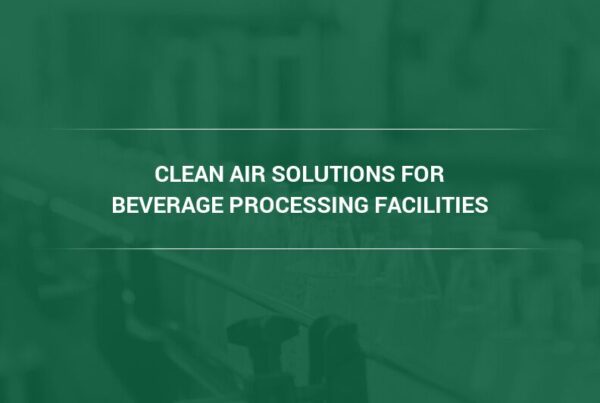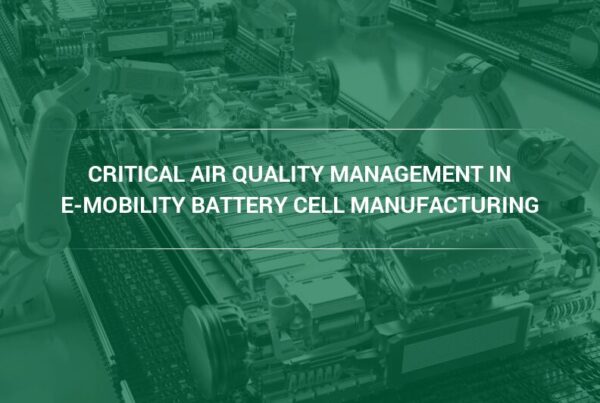Maintaining good indoor air quality in any commercial or public building can be challenging due to the complexity of the structure and how each space within the building is used. Food processing facilities, however, present even more complex indoor air quality challenges due to increasingly stringent food hygiene and safety regulations.
Operators need to protect the health and safety of workers, food processing equipment and technology, as well as the actual food products before being transferred from the plant to store shelves. Operators also must keep all processes running smoothly to maximize productivity and minimize product loss.
Temperature and humidity requirements make food processing facilities more susceptible to airborne microbes and viruses that can increase risk and hamper performance. Air filters play a critical role in maintaining good indoor air quality by limiting the presence of airborne microbes and viruses in food processing environments.
The Imperative of Indoor Air Quality in Food Processing
In addition to protecting the health and safety of employees, the top priority in food processing environments must be to ensure the safety and integrity of food being processed for human consumption.
Air filters can limit microbiological cross-contamination with bioaerosols, which are solid or liquid particles that carry microbes through the area. Bioaerosols include bacteria (salmonella, E. coli, listeria etc.), viruses, pollen, mold and dust. Air filters can also be used that are specifically designed to minimize volatile organic compounds (VOCs) such as benzene and formaldehyde.
Properly installing and maintaining the right air filters will enable processing facilities to satisfy regulatory and compliance standards in food production, including:
- Food Safety Modernization Act (FSMA) regulations for the prevention of foodborne illnesses.
- Good Manufacturing Practices (GMPs) for sanitation, personnel hygiene, facility design, equipment maintenance and other aspects of food processing.
- Hazard Analysis and Critical Control Points (HACCPs) for identifying and controlling food safety hazards and reducing risk.
- FDA and USDA regulations that apply to facilities handling different types of food products.
- International regulatory standards such as ISO 22000 for food safety management systems.
Poorly maintained HVAC systems with mismatched air filters can allow high amounts of biological air pollutants into indoor environments, increasing the risk of contamination and compromising the quality of the products. For example, a commonly used air handling unit rated at 100,000 CFM (cubic feet per minute) could flow millions of bacteria into a building every minute.
A good phrase for production facilities to keep in mind is: air is an ingredient in food. Whatever is in the air when the package is sealed will be there, in one format or another, when that package is opened by the consumer. Airborne microbes can not only cause health issues, but they can have an impact on a food product’s shelf life and flavor. If you’ve ever seen what happens to an apple, a piece of meat or a block of cheese left uncovered on a countertop after a period of time, you’ve witnessed what can happen.
Challenges in Air Quality Management for Food Processing Units
Various types of bioaerosols, dust particles, odors, gases and VOCs are constant hurdles to air quality management because they can be harmful to both human employees in the plant and the food being processed.
The building structure itself can make air quality management even more difficult, given the complexity of design, different types of activities in different spaces, and varying occupant densities in each space. Creating a system that can maintain the proper filtration and ventilation performance, temperature and humidity throughout the entire food processing facility – and meet all regulatory standards – requires a significant amount of planning, testing, and expertise.
Understanding the external environment is also critical to air quality management. HVAC systems constantly pull a certain volume of outside air, often mixing with recirculated plant air before filtering the air and pushing it back into the indoor environment. This process can be more difficult if the food processing plant is surrounded by heavy auto traffic and emissions from other manufacturing facilities. However, even natural environments with trees, vegetation, rivers and streams can produce pollen and allergens that need to be filtered before entering a food processing space.
Air Filters: Fundamentals Tailored for Food Processing
Various types of air filters are used in food processing facilities to trap bioaerosols and other contaminants. While regulations are strict in these environments, the government provides limited guidance about the appropriate filtration levels rather than strict requirements. Facility operators make the final decisions.
Of course, operators must still satisfy the regulations mentioned previously. Food processing companies should partner with qualified air filtration and ventilation professionals to identify metrics for evaluating air quality outside and inside their facilities. Informed decisions about the level of filtration can then be made to ensure compliance.
There are several rating systems used to measure the efficiency of air filters in capturing particles of different sizes, including:
- MERV (Minimum Efficiency Reporting Value): Capable of capturing particles of certain sizes based on a rating scale of 1-16. . The higher the rating, the smaller the particle that the filter is capable of tracking.
- HEPA (High-Efficiency Particulate Air): A type of filter tested and certified to a minimum efficiency level of 99.97% on 0.3-micron-sized particles. The high-pressure drop of the filter requires specialized frames and gaskets but is invaluable in certain food processes. ULPA (Ultra-Low Penetration Air): For environments that require exceptionally clean air, ULPA filters can be 99.9995% efficient.
Generally, food processors use a rooftop unit with two stages of filtration. The heating element is sometimes in front of the filtration stages and the cooling element is often between the filtration stages. Both heating and cooling elements can be a source of moisture, so moisture separators may be required to prevent performance degradation.
The first stage of filtration, or prefilter, has a lower MERV rating and is designed to remove larger debris and pollutants. The second stage, or final filter, must continuously capture a certain size and percentage of particles identified as harmful without compromising airflow pressure.
Types of air filters used in food processing facilities include:
- Mechanical Filter: Installed in the air handling system and uses filter media to capture particles with maximum efficiency.
- HEPA Filter: A type of mechanical filter that can capture particles as small as 0.3 micrometers in diameter, such as mold, allergens, pollen, and dust.
- Activated Carbon Filter: For odors, gases, and VOCs.
- Dust Collector: Circumstances where exceptionally large amounts of contaminants are generated such as in a flour mill.
Choosing the Right Air Filter for Food Processing Facilities
There could be as many as three types of air filtration systems to minimize exposure of people, food and equipment to bioaerosols:
- The main HVAC system, typically on the roof, controls heating and cooling.
- Process filters, such as HEPA filters, protect the air entering a specific piece of equipment.
- Air purification systems provide additional airflow in areas known to generate contaminants.
High-efficiency air filters should be used within these systems to prevent the entry and circulation of harmful contaminants. Ventilation systems should be designed to optimize air delivery so positive pressure, especially in “clean” areas such as food packaging and storage, can be maintained.
Air filters with a MERV rating of 14 or above are a good starting point for capturing bioaerosols in a food processing facility. Ultimately, the precise filtration needs must be determined by the individual facility based on the type of food being processed and all regulations that apply. Look for a filter with a MERV-A rating, which indicates the filter has been tested in conditions that simulate real-world situations and will not drop in efficiency.
Historically, prefilters have had a limited service life, but modern filter technology makes it possible to use filters with higher MERV ratings and longer life to protect equipment, assist with moisture removal, and begin the process of cleaning the air for food contact. Air handling units with enough space in the prefilter stage to install 22-inch deep, MERV 11A pocket filters can get up to 12 months service life.
It is importantto check the lifespan of each type of filter to ensure consistent food quality. Filters with a short lifespan not only must be changed more frequently, which drives up costs, but also can affect the quality of the food being processed.
There are many moving parts involved with maintaining proper indoor air quality in a food processing facility. Budgets, however, are not infinite. It’s important to partner with an experienced clean air solution provider sostakeholders in the selectionprocess are equipped to make an informed decision for maximum ROI and optimal air filtration. .
Modern Advancements in Air Filtration for Food Processing
With government and industry regulations increasing in number and complexity, innovations in air filtration technology and capabilities have been developed to help food processors monitor air quality and prevent costly violations. Modern air filters also have innovative materials that can capture a higher percentage of ultrafine contaminants, moisture, VOCs, and more while reducing energy consumption and improving air filtration efficiency. In addition to protecting food from contamination, modern air filters can prevent disease from spreading.
Air Filter Maintenance: Ensuring Continuous Protection
Contaminants and bioaerosols are often traced back to water. HVAC, air filtration systems and ventilation systems should be designed to prevent pooling of water. Cooling coils, drip trays and evaporative condensers must be inspected and maintained often to avoid buildup of contaminated water.
Air pressure should also be monitored and tested to maintain proper airflow. In addition to replacing the air filter when airflow falls below rated values, all debris, dust and obstructions to airflow should be cleaned and removed. The maintenance process should be documented and scheduled, and the entire system should be tested after maintenance to ensure optimal function.
Keep in mind that regular maintenance and inspections are needed to satisfy compliance requirements. These tasks should be handled and reported by a licensed technician.
Case Studies: Triumphs in Air Filtration for Food Processing
Camfil is recognized for designing, installing, and maintaining air filtration solutions for food processing facilities around the globe to elevate air quality, optimize system performance and avoid costly compliance violations.
- See how Tonnies Group meat processing facilities overcame a lack of industry ventilation standards and COVID risks, using CC6000 and CC2000 air cleaners with H14 HEPA filters to remove airborne microbes and particles from the indoor environment. Read the case study.
- Learn how Camfil helped one of North America’s largest packaged food companies dramatically improve air filtration and save more than $33,000 in annual energy and filter costs. The client also won a utility rebate check for reducing overall energy use. Read the case study.
Conclusion: Prioritizing Pure Air in Food Production
More than an employee safety issue, indoor air quality in a food processing facility is a public health issue. The role of air filters in preventing health problems and protecting critical investments in technology and food processing equipment cannot be overstated.
Camfil encourages food processing companies to schedule HVAC, filtration, and ventilation system inspections and evaluations s to ensure sufficient performance and compliance with regulatory standards. Investing in modern equipment and air filters will result in not only safer conditions but increased energy efficiency and a more resilient infrastructure. Smart technology will also enable you to monitor indoor air quality more closely and address air quality issues proactively.
Just like surfaces and tools used to prepare and serve food need to be cleaned, the air to which food is exposed needs to be clean and safe. Camfil is a global leader in providing food processing facilities premium air filters, technical know-how and industry experience to maintain clean, safe indoor air.



